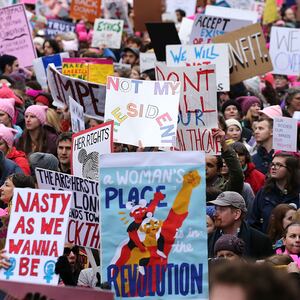Countless headlines boomed after Democrats captured the House this past November along the lines of “The Women Did This!” And they were 100 percent correct. Exit polls made it clear that women had delivered this victory by voting for Democratic congressional candidates over Republicans by a never before seen 19-point margin. The closest to that showing in a midterm was more than 30 years ago in 1982 when women cast their ballots for Democratic candidates by a 17-point margin.
There’s a compelling argument to be made that we would’ve never seen this victory, nor the record number of Democratic women running and winning in the 2018 election, if not for the Women’s March in 2017.
But instead of the leaders of that inspiring event being able to take a victory lap this Saturday when the third March takes place, they are embroiled in a controversy—of their own making—over their ties to Louis Farrakhan, a man who has a long history of spewing vile, anti-Semitic hate, including in October when he took a page from Nazi propaganda by comparing Jews to insects.
ADVERTISEMENT
When news first broke that one of Women’s March organizers, Tamika Mallory, attended a Farrakhan speech in February 2018 where he delivered anti-Semitic comments, the initial reaction by Mallory and two other March leaders, Carmen Perez and Linda Sarsour, ranged from silence to defending Farrakhan’s work on behalf of the African-American community.
Within two weeks they did put out a long statement declaring that the March will “not tolerate anti-Semitism” or any form of hate and that they “condemn these expressions of hatred.” They also mentioned Farrakhan by name, writing his views about “Jewish, queer and trans people are not aligned with the Women’s March Unity Principles.”
This statement, however, clearly fell short, since saying “not aligned” is far from unequivocally denouncing his words and hate-filled views. As a result, the March has been dogged by controversy ever since. And it escalated for the worse a little over a week ago when Mallory appeared on ABC’s The View and refused to unambiguously denounce the despicable anti-Semitic comments of Farrakhan, instead saying his words were “not my language.”
This may or may not be the last annual Women’s March. But the organizers and all those who were part of the first March still deserve credit for their role in arguably giving birth to the Resistance to Trump.
Think back to Jan. 20, 2017, when Trump was being sworn in as the 45th president. For many, his victory was a shocking wake-up call that nearly 63 million of our fellow Americans could cast a ballot for a man who openly spewed racism, called for a total and complete ban on Muslims and, as seen on the infamous “Access Hollywood” video, bragged about sexually assaulting women. These Americans either supported Trump’s racism, bigotry and sexism or were not troubled by it. In either case, it was beyond worrisome; it was frightening.
And being Muslim, I saw palpable concern in my community that if there were a major terrorist attack by ISIS in the United States, Trump would call for internment in camps of Muslim Americans, at least of young Muslim men. Alarmingly, the United Supreme Court case, Korematsu v. United States, that upheld FDR’s internment of Japanese-Americans—over 60 percent of whom were American citizens—was still valid in 2017. (Ironically, the U.S. Supreme Court decision in June 2018 upholding Trump’s partial Muslim ban finally overruled that case.)
But then came Jan. 21, 2017 and the first Women’s March. That day, three to five million women and their allies took to the streets of America in more than 600 cities to make it clear that Trump’s vision of an America that celebrated cruelty, racism and sexism would not come to be without a fight. Many experts said this was the largest demonstration in our nation’s history. And importantly from a psychological point of view, an estimated three times more people took to the streets of Washington, D.C. to be a part of the Women’s March as attended Trump’s inauguration the day before.
For those like myself who wondered if we belonged in Trump’s America, that massive showing made it clear to us that there were more of us then them—at least on those back-to-back days. And while anecdotal, I spoke to countless women in 2017 who shared how the first Women’s March was their entry point into the Resistance. Some were younger women who had never attended a political rally before. Others were older who explained they hadn’t been to a rally since the 1960’s but Trump’s victory motivated them to get back into the streets.
From that first march many women—and their male allies—also began to become more engaged in other Resistance activism, from the then-newly founded grassroots group, Indivisible.org, which now boasts hundreds of chapters across the country, to a spike in membership in established progressive groups like Moveon.org.
And arguably the rallies a little over a week after the first Women’s March at airports across the country when Trump first attempted to impose his Muslim ban were an outgrowth of a motivated base of people who realized that street action can make a difference.
This, not the controversy the Women’s March leaders could've and should've ended long ago, is the true legacy of the Women’s March. And regardless what happens to the March after this year, that first Women’s March may also be a big part of the reason why the Democrats defeat Trump come 2020.







